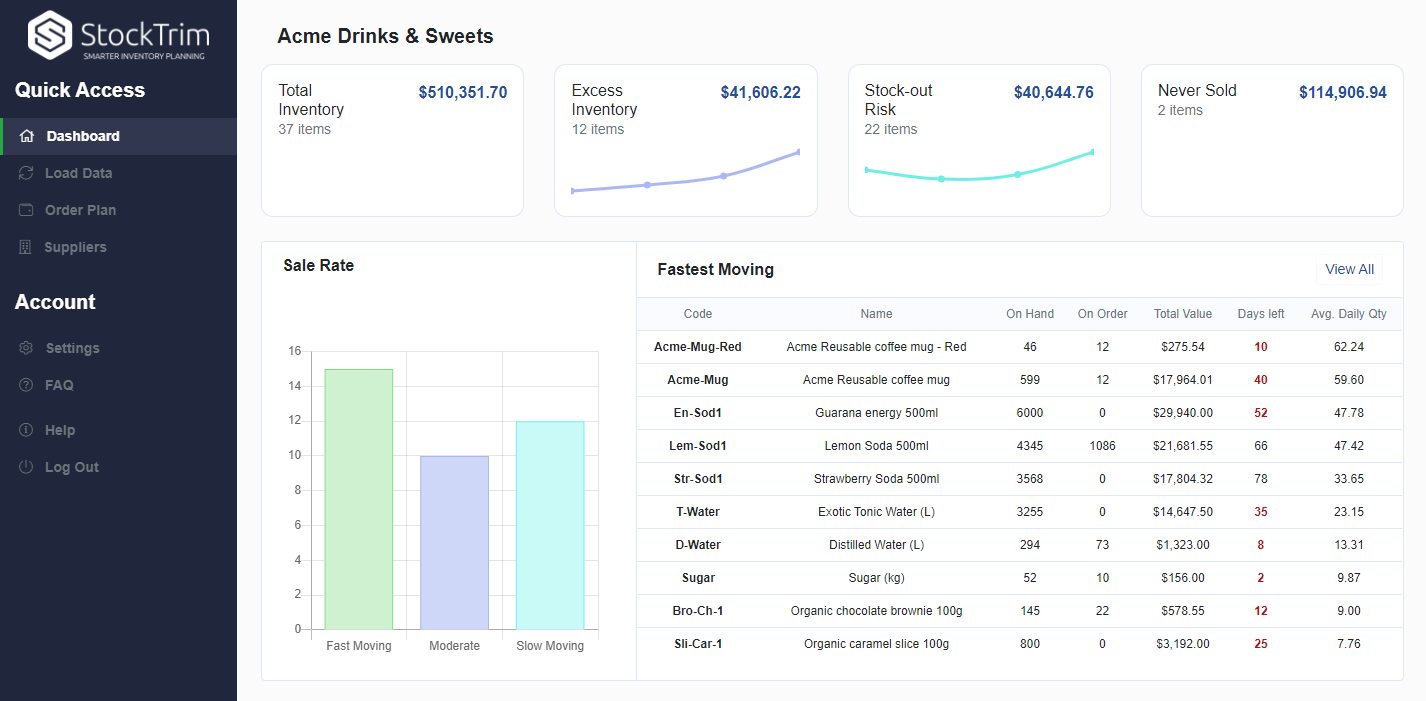What's the difference between Inventory Management & Inventory Forecasting you ask?
In a nutshell – Inventory Management deals with what you have, Inventory Forecasting deals with what you should have.
Inventory management is the whole practice of everything you do with your inventory, dealing with tasks such as the recording of incoming & outgoing stock, keeping track of how much stock you have on-hand in each of your locations, and which items to order from each supplier.
Inventory forecasting is an important and difficult part of inventory management that deals with making an informed decision about how much stock to order, and when.
- Inventory Management: Focuses on the real-time physical handling, tracking, and control of existing inventory. This includes ordering, receiving, storing, and shipping stock.
- Inventory Forecasting: Looks into the future to predict demand and determine the ideal amount of stock to have on hand. It's a proactive approach that aims to optimize cash flow, prevent stockouts, and minimize the costs associated with holding too much inventory.
The simplest approach is to set a ‘reorder point’ for each item of stock (SKU), and place new orders with your suppliers when the stock level reaches this point. It can be very difficult to set this accurately to the optimal level. However, since it relies on predicting demand and making sure you have enough stock on hand to cover the lead time between placing the orders and when the stock arrives.
One of the most common causes of a business regularly going out of stock with items, or having excess capital tied up in stagnant inventory is that their reorder points are incorrect.
 Therefore, it’s a great idea to take a continuous approach to inventory forecasting.
Therefore, it’s a great idea to take a continuous approach to inventory forecasting.
Challenges of Setting Reorder Points:
- Demand Variability: Sales fluctuate due to seasonality, promotions, and other factors, making it hard to predict future demand accurately.
- Lead Time: The time between placing an order and receiving the goods adds complexity to forecasting.
Buffer Stock: Holding extra stock as a safety net against unexpected demand spikes can lead to excess inventory costs. - Benefits of Continuous Forecasting:
Increased Accuracy: Continuously analyzing data (past sales, promotions, market trends) allows for more dynamic and adaptable reorder points. - Reduced Stockouts: Improved forecasting minimizes the risk of running out of popular items, leading to lost sales and customer dissatisfaction.
- Optimized Cash Flow: By having the right amount of stock, businesses can avoid spending capital on unnecessary inventory while ensuring they have enough products to meet demand.
There are many factors that should be taken into account to make a great inventory forecast - your sales history to get a good idea of the demand trends, buffer stock to account for variability and uncertainty, plus any other adjustments for expected changes in demand (do you have new products or promotions coming up)?
Every time you place your orders, be it every day, every week, or every month, these factors should then be compared with the current stock level and the supplier lead time to come up with the optimal order quantity for each product. Getting this right will ensure you always have just enough stock on hand, but without over capitalizing with your inventory.

Additional Considerations:
- Forecasting Methods: Different methods exist, from basic statistical models to machine learning algorithms. The best method depends on the specific industry, product, and available data.
- Software and Tools: Inventory forecasting software can automate calculations, analyze data, and generate reports, making the process more efficient and accurate.
- Collaboration: Involving cross-functional teams (sales, marketing, operations) in the forecasting process can lead to a more holistic and well-informed approach.
A Case Study:
Ace Bikes - From Stockouts to Smooth Sailing with Inventory Forecasting
Background: Ace Bikes, a thriving bike shop in the city, had grown rapidly over the past few years. While this was positive, it also brought inventory management challenges. They often faced stockouts of popular models during peak seasons, leading to lost sales and frustrated customers. On the other hand, they also overstocked certain models, tying up valuable capital in stagnant inventory.
Inventory Management vs. Forecasting: Initially, Ace Bikes relied solely on a basic "reorder point" system. They tracked past sales and set thresholds for each model, automatically placing orders when stock reached those levels. However, this method proved inadequate:
- Demand Variability: Reorder points didn't consider seasonal fluctuations or marketing campaigns, leading to unpredictable stockouts and overstocking.
- Lead Time: With a long lead time from suppliers, relying solely on past sales data left them vulnerable to unexpected demand surges.
- Unoptimized Cash Flow: Ace Bikes ended up with too much inventory during slow periods and insufficient stock during peak times, impacting their cash flow and customer satisfaction.
Implementing Inventory Forecasting: Recognizing the limitations of their existing system, Ace Bikes switched to a data-driven inventory forecasting approach. They partnered with a software provider that implemented a solution:
- Historical Data Analysis: They analyzed past sales data, considering seasonality, marketing campaigns, and economic trends.
- Statistical Models: Machine learning algorithms predicted future demand with greater accuracy, taking into account external factors like weather and competitor promotions.
- Buffer Stock Optimization: The software suggested optimal buffer stock levels for each model, factoring in lead time and demand variability.
Results: Within a year of implementing inventory forecasting, Ace Bikes witnessed significant improvements:
- Reduced Stockouts: They experienced a 75% reduction in stockouts, leading to improved customer satisfaction and increased sales.
- Optimized Inventory Levels: Excess inventory was reduced by 40%, freeing up capital for other investments.
- Improved Cash Flow: Inventory forecasting ensured smoother cash flow, optimizing stock levels and minimizing inventory holding costs.
If you'd like to try a FREE trial of our inventory forecasting software, click the green button to get started:



